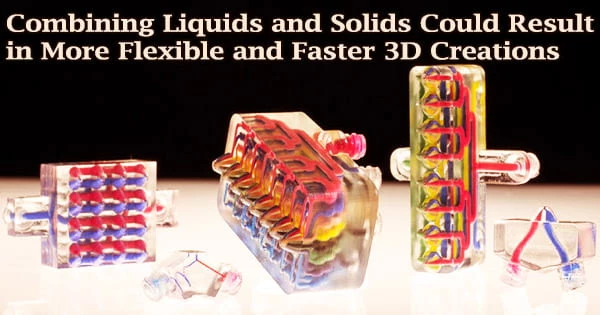Imagine a world when you could 3D-print a full robot or flexible, electronic medical equipment at the touch of a button, eliminating the need for hours of painstaking manual assembly. Thanks to a significant development in 3D-printing technology led by experts at the University of Colorado Boulder, that prospect may be closer than ever.
The team lays out a technique for using currently available printers to make materials that blend solid and liquid components, which is a difficult task if you don’t want your robot to collapse, in a recent paper.
“I think there’s a future where we could, for example, fabricate a complete system like a robot using this process,” said Robert MacCurdy, senior author of the study and assistant professor in the Paul M. Rady Department of Mechanical Engineering.
The findings were published in the journal Additive Manufacturing on April 14, 2022 by MacCurdy and PhD students Brandon Hayes and Travis Hainsworth.
3D printers have long been the domain of amateurs and laboratory researchers. They’re skilled at creating plastic dinosaurs and specific machine parts like gears and joints.
But, according to MacCurdy, 3D printers can do much more: by combining solids and liquids, they may create systems that are more flexible, dynamic, and perhaps more valuable. Wearable electronic gadgets with liquid wires trapped within solid substrates, as well as models that simulate the squishiness of real human organs, are among them.
The engineer compares the innovation to classic printers that print in color rather than black and white.
“Color printers combine a small number of primary colors to create a rich range of images,” MaCurdy said. “The same is true with materials. If you have a printer that can use multiple kinds of materials, you can combine them in new ways and create a much broader range of mechanical properties.”
Color printers combine a small number of primary colors to create a rich range of images. The same is true with materials. If you have a printer that can use multiple kinds of materials, you can combine them in new ways and create a much broader range of mechanical properties.
Robert MacCurdy
Empty space
Comparing 3D printers to regular printers in your company might help you grasp such qualities. Liquid inks are laid down in hundreds of flat pixels by paper printers to generate an image. In contrast, inkjet 3D printers use a printhead to drop small beads of fluid called “voxels” (a combination of “volume” and “pixel”) one on top of the other.
“Very soon after those droplets are deposited, they are exposed to a bright, ultraviolet light,” MacCurdy said. “The curable liquids convert into solids within a second or less.”
However, there are several situations in which those liquids should remain liquid, he continued. For example, some engineers utilize liquids or waxes to form microscopic channels within solid objects, which they then empty afterwards. It’s similar to how water drops can carve out an underground tunnel.
Engineers have devised methods for creating such empty spaces in 3D-printed objects, but cleaning them usually takes a long time and effort. The channels must also remain straightforward.
MacCurdy and his colleagues set out to overcome these restrictions by better understanding the circumstances that would allow engineers to print solid and liquid materials simultaneously.
Liquid courage
The researchers started by creating a series of computer simulations to investigate the mechanics of printing different materials next to each other. One of the major issues, according to MacCurdy, is how to keep solid-material droplets from mixing with liquid-material droplets, even when the solid-material droplets are printed immediately on top of the liquid droplets.
“We found that the surface tension of a liquid can be used to support solid material, but it is helpful to pick a liquid material that is more dense than the solid material the same physics that allow oil to float on top of water,” Hayes said.
The researchers then used an actual 3D printer in the lab to test their findings. They inserted a curable polymer, or plastic (the solid), into the printer, as well as a typical cleaning solution (the liquid). The crew was able to 3D-print twisting loops of liquid and a complicated network of channels that looked similar to the branching paths in a human lung.
“Both structures would have been nearly impossible to make through previous approaches,” Hainsworth said.
MacCurdy has also just joined a team of CU Boulder and CU Anschutz Medical Campus academics working on techniques to 3D-print realistic human tissue models. These simulations could be used by doctors to perform procedures and make diagnosis. Among other tools, the research will use MacCurdy’s liquid-solid technique.
“We hope that our results will make multimaterial inkjet 3D printing using liquids and solids more accessible to researchers and enthusiasts around the world,” he said.
















